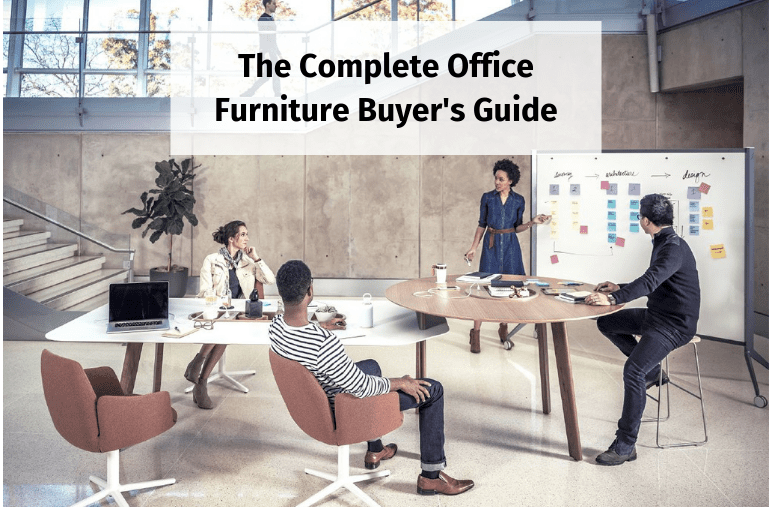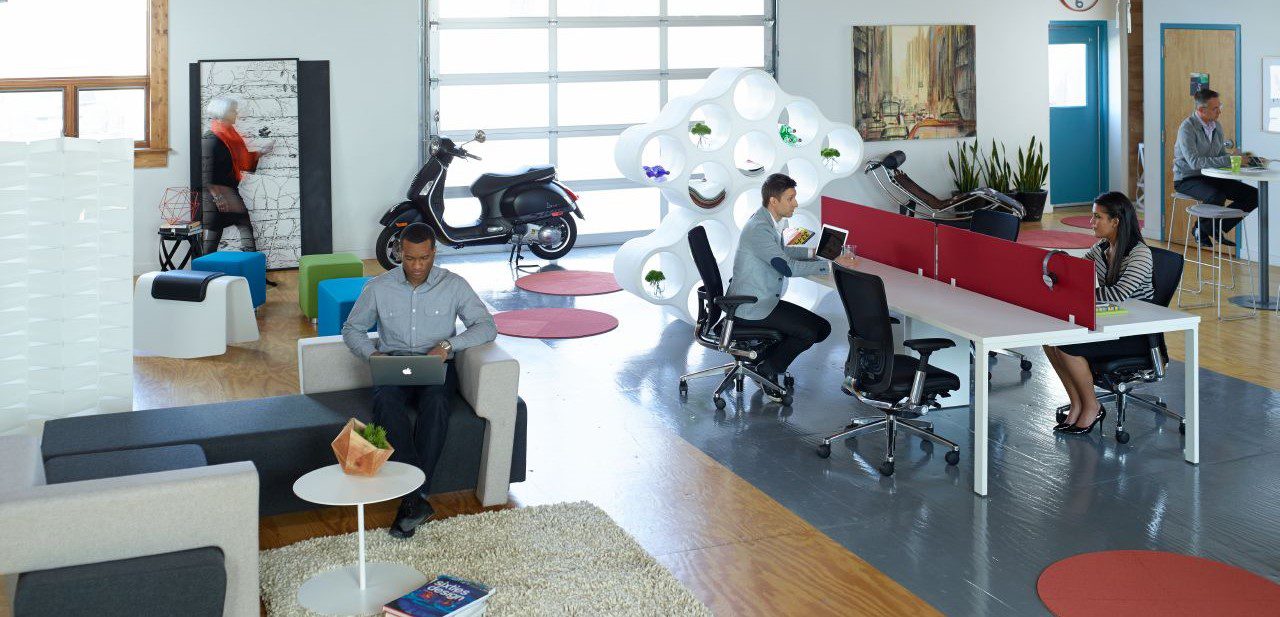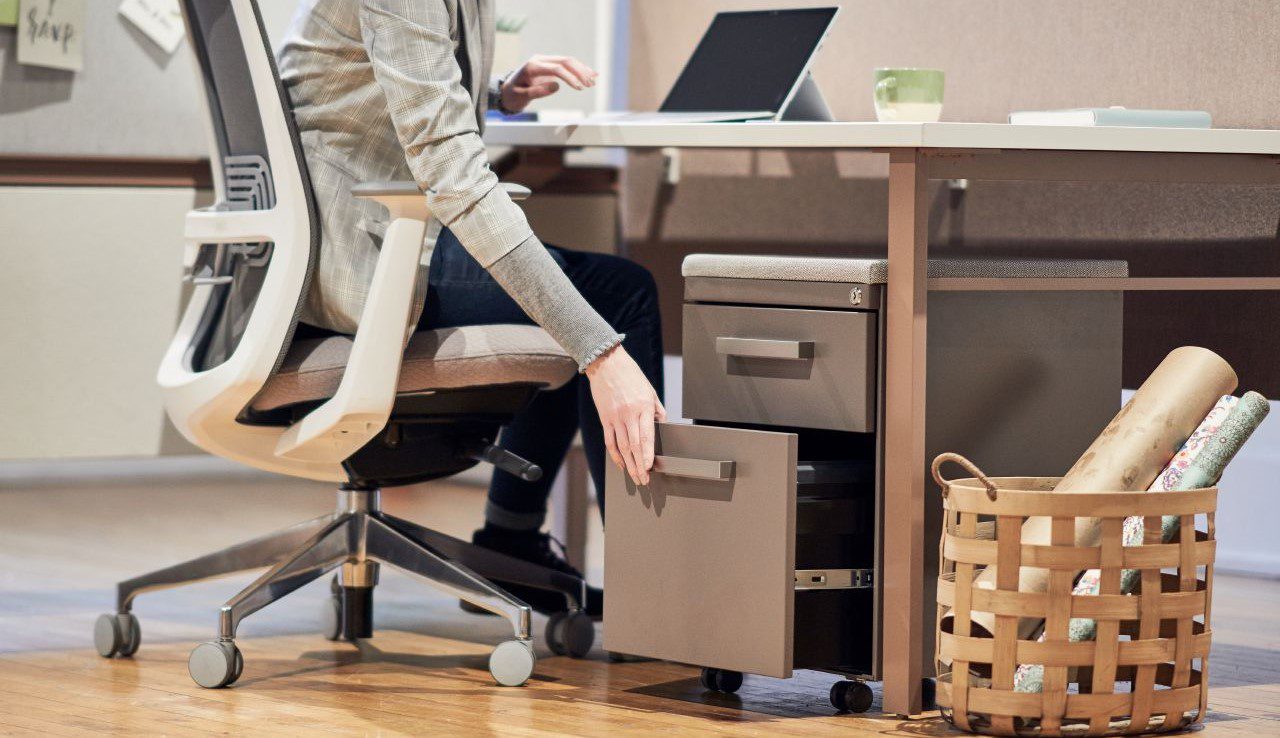Buying office furniture can be a complex, drawn-out, and frustrating experience. But it really shouldn’t be.
Yes, the products are highly customizable, and the options are virtually limitless. Yes, lead times can often drag on for weeks or months depending on the product and manufacturer. That isn’t why the process of buying office furniture can sometimes feel so painful though.
Buying office furniture can be hard because it is so difficult to find the information you need, up front, before being pulled into a consultation with a salesperson.
We decided to fix that. Enter, the Ultimate Guide to Purchasing Office Furniture. In this document, we will answer the questions we are asked most frequently about buying furniture so that you can do the research you need to feel comfortable about your next purchase.
Table of Contents
- Factors to Look for When Choosing Office Furniture
- The Furniture Buying Process
- Office Furniture Costs
- Office Furniture Warranties
- What to Look for in an Office Furniture Provider
Factors to Look for When Choosing Office Furniture
Depending on your situation, there are many different factors to keep in mind when choosing your office furniture. We feel this list of potential factors though can be distilled down to just seven critical criteria.
Aesthetics
The look of your workplace can play a critical role in the success of your company. Studies have shown that an aesthetically pleasing office can help with attracting and retaining top talent.
The culture of your team and workplace is essential when trying to recruit and retain, investing in the space where your people spend one-third of their daily life is an important signal that you value them, their time and their health.
Ergonomics
The science of designing a workplace with the abilities and needs of your employees in mind, also known as ergonomics, should be factored into every piece of office furniture you purchase.
From footrests to adjustable monitor arms or chairs that properly support the lower backs of your employees, ergonomics can have a significant impact on the productivity, health, and happiness of your team members. Choosing office furniture built with ergonomics in mind is essential for any efficient workplace.
Adjustability and Flexibility
Employees come in all different shapes and sizes, which is why the office furniture you choose needs to have the flexibility required to meet their individual needs. Many desks and table solutions are height adjustable to ensure employees can be productive while maintaining proper posture.
Likewise, the office chairs you choose should include features such as adjustable arm, head, and backrests. Investing in furniture that can be adjusted to the specifications of your employees can help keep everyone in the office comfortable and focused on their work.
Warranty
Office furniture is a substantial investment, and you want to be sure that dependable warranties back the pieces you choose. This will ensure that if you experience an issue with your office furniture, you’ll be able to have it dealt with quickly and at a reasonable cost.
Impact on Employee Wellness
The right office furniture can greatly impact the lives of your employees. Several studies have found that choosing office furniture that is both comfortable and ergonomically considered can have a noteworthy impact on employee happiness, as well as their productivity.
Multi-functionality
To maximize your budget purchase furniture with multiple functions in mind. For example, lounge or storage furniture can also be used for collaborative or meeting spaces.
Many desks are designed primarily to function as single employee workstations, but can easily be transformed into collaborative hubs. Similarly, tables can be designed to move around the office as they’re needed, making them perfect for in-house presentations, training programs, strategy sessions in the board room, and much more.
Brand Reputation
When choosing office furniture, it’s essential to work with a brand that has earned a reputation as a leader. The reason is simple: choosing the best will help bring the best out of all your employees.
Always choose products from office furniture brands who are all known for using quality building materials and are committed to delivering the best furniture in an environmentally responsible way.
Back to top
The Furniture Buying Process
The process of buying office furniture can be boiled down to nine key stages: product selection, drawings, finish selection, quote supplied, customer sign-off, order entry, manufacturing, shipping and finally, delivery & installation.
Let’s break down each of these stages to explore what needs to be accomplished to continue through the process as well as estimate how long you should expect to spend working through each step.
1. Product Selection – one week (highly variable, but this is a reasonable expectation)
The first step when purchasing office furniture is to select your furniture. For a simple order, this stage could take a mere day or two. For a large project or if multiple on-site meetings are required to get a clear grasp of your needs and determine the right solutions, this step could take a few weeks. As the customer, you have a high degree of influence over how long this step will take.
2. Drawings – 1 to 2 days per revision
In this step your desired products and floorplan have been given to our CAD team to complete CAD drawings of the configuration which ensure that all the necessary parts are included in the order, everything will fit with your floorplan restrictions and to provide a blueprint for the installation team.
A skilled CAD team can turn around a set of revisions in one to two business days; the primary factor determining the length of this step is how many sets of alterations or changes you request.
3. Finish Selection – 1 to 3 days
Once your furniture has been selected and your layout configured comes the fun part; picking finishes! Your Account Manager will present you with finish options for your chosen products, how long you wish to consider your options before making a final selection will be the main factor limiting the amount of time this step can take.
4. Quote Supplied – 1 to 2 days
After all the finishes have been selected, and the drawings finalized, it’s time for your Account Manager to prepare a quote. This typically takes one to two business days, depending on the size and complexity of the order.
5. Customer Sign-Off – 1 to 3 days
In this step, the customer must sign off on their received quote and confirm that they want to proceed with placing the order. If all internal stakeholders who must approve the purchase have been kept up to speed during the previous four steps, customer sign-off can be much faster. Progress through this stage is entirely in the customer’s hands.
6. Order Entry – 1 to 2 days
Once the customer has signed off on their quote and returned it to their Account Manager, a Furniture Sales Coordinator (FSC) will then process the order. The FSC will create a file in the dealer’s project management and accounting system as well as order the product from the various manufacturers.
7. Manufacturing – 4 to 5 weeks
After all the manufacturers have acknowledged the order and provided their estimated ship dates, your FSC will provide you with an update as to when they expect the product to arrive. Unfortunately, this is the step in the process where both the dealer and customer have the least control over time frames.
Most manufacturers operate on a Just-In-Time manufacturing system and do not begin building product until they have received an order. Typical manufacturing lead times are four to five weeks for standard products, but customized “special” orders can stretch out much further, and if you are ordering a designer product or furniture that is manufactured overseas you can experience lead times of as high as 12 or even 16 weeks!
One way to cut down on lead times is to order off a manufacturer’s “Quick Ship” list. Manufacturers often create a Quick Ship list of some of their most popular products with a limited selection of finishes and promise to either keep them stocked or prioritize them in manufacturing. Quick Ship lead times are usually one to two weeks, depending on the manufacturer.
8. Shipping – 1 week
The leading commercial office furniture brands sold in Canada are manufactured within North America, so it usually takes one week for your dealer to receive the product. As with the manufacturing stage, there is often little that either the customer or the dealer can do to reduce the length of this stage.
9. Delivery and Installation – 1 to 5 days
When your dealership has received all your product from the manufacturers, your FSC will provide you with an additional update letting you know that your product has arrived and that installation is being scheduled.
Typically, delivery and installation will take less than one week. However, since delivery must be coordinated with the customer, delivery could be scheduled sooner or later depending on the availability of both an installation team and the customer’s facility. Timely scheduling is depending on excellent communication and cooperation between the dealer and the final customer.
How Soon Will I Receive My Furniture?
All in all, you should expect it to take between seven and ten weeks to buy office furniture from the first conversation with an Account Manager until your furniture is fully installed.
If trying to estimate how long it will take to receive your furniture from the date you placed your order, you should budget five to seven weeks.
Back to top
Office Furniture Costs
Price doesn’t always equal value received. To make sure you are buying quality furniture, without overpaying, you need to understand how much to budget for your next furniture purchase.
Task seating
Ultimately what determines how much you should spend on an office chair is how much you plan on using the chair. Are you looking for a chair that you can keep using for years to come? Do you plan on using the chair every day? Will you be sitting in the chair for the bulk of the workday? If you answered yes to these questions, you should budget between $350 and $800 for a task chair.
So why are some chairs more expensive than others? Here are the three factors that can significantly impact a chair’s final price point:
1. Durability has a price
If a chair retails over $350 extensive warranties typically support it and you should expect a useable life of at least five to ten years.
2. More features mean more money
There are dozens of ergonomic features and customizations available these days, but an upcharge of $20-50 each accompanies many.
3. Finish choice can significantly impact the final cost
The list price is almost always for the standard grade finish and not for more premium finishes. For example, if you upgrade the base of a task chair from plastic to polished aluminum and the fabric from upholstery to leather, the cost of the chair can double.
Desks
The typical desk these days is a 6’x6’ L-shaped configuration casegood. You should typically count on spending between $700-$5000 for a 6’x6’ desk. While the range is rather broad, ultimately, it can’t be narrowed until you make two choices:
- How much storage do I want to incorporate into my desk?
- What kind of finish do I want / Do I want a laminate or veneer work surface?
Storage
The amount of storage capacity incorporated into a desk or workstation is a significant factor in its overall cost. When deciding how much storage you want your desk to have, take the opportunity to think about how much you actually need.
Finishes
There are two common types of finishes for desks these days, laminate and veneer; your choice can have a significant impact on the final price you pay. A veneer is unmatched in appearance and selection options but is very much priced as a premium option. Laminate is a lower cost and lower maintenance option but does not have quite the same aesthetic impact of a veneer worksurface.
Workstations
Similar to desks, workstations have shrunk in size in recent years and are most commonly seen in 6’x6’ L-shaped configurations although the nature of systems furniture does allow for a lot of creativity in the specific layout design. A safe budget range would be approximately $1200-$4000 per workstation.
Once again, where you land within this range is primarily determined by how much storage you desire and what finishes you select.
Storage
As with many things, the more you add, the more it’s going to cost. Before committing to a particular configuration, we suggest you take the opportunity to evaluate just how much storage you (and your team) need at your workstation.
- Do you need to have a space for storing binders at your desk or can you use a shared bookcase instead? What about paper documents and files?
- Do you need that storage tower for your coat and umbrella, or would it be more efficient for the office to share one centrally located closed?
Finishes
Here are a couple of the frequent upgrades that I many new customers may not realize can quickly run up the cost of your workstation(s):
- Upgrading the panels from a single colour fabric to laminate or veneer
- Built-in writeable whiteboard surfaces on the panels
- Adding a glass (clear, glazed or framed) to the top of the panel for a little additional auditory privacy while maintaining the same open visual feel.
Office Furniture Warranties
Office furniture warranties can be murky when compared with the warranties of other products. After all, most warranties guarantee that the product will continue to function for a defined period, but a table can take quite a bit of abuse before it stops functioning as a table. Just how much damage constitutes regular wear and tear and how much justify a warranty claim?
Does sun damage to your fabric qualify for a warranty claim? What about if your brand-new chair looks just as promised, but isn’t comfortable?
Add in the fact that many furniture manufacturers will sell additional extended warranties on top of their standard warranties and you have a recipe for confusion.
From our experience, we have found that the best way to view a furniture warranty is as a representation of the quality of that furniture. Does the manufacturer back up their product with a long-term comprehensive warranty or does it offer a brief window of eligibility with plenty of legalese exceptions and conditions?
What Warranties Are Available for Office Furniture?
There are three major types of warranties in the office furniture market.
1. Full Warranty
Full warranties are rare. This is an unlimited product performance guarantee that effectively lasts forever. Anyone can send in a product with a full warranty for repair or replacement, and the manufacturer guarantees that it will perform the service, often with a “no paperwork, no questions asked” policy.
2. Limited Warranty
These are warranties subject to manufacturer-determined limits. The most common form of restriction is on the duration of the warranty – for example, a “ten-year limited warranty.” But manufacturers can also set other limits to their guarantees.
For office furniture, it is unusual for manufacturers to establish performance limits for warranties, but it does happen. One example is weight limits for desks and load-bearing furniture.
3. Express Warranty
An express warranty is any performance guarantee made by a company about its products. This includes advertising messaging, promotional messaging, and even promises made by salespeople – if they write it down.
If an office furniture salesperson promises that a desk can withstand up to 150 pounds of dead weight and you convince that person to write that statement down on the company invoice, you have an express warranty on desk performance.
In that case, you can claim that desk warranty if a 140-pound person sits on the desk and causes it to collapse. For this reason, furniture providers are generally cautious not to make express warranties about their products.
Common Problems with Office Furniture Warranties
A single manufacturer may provide a different warranty for each of its products. This means that even though your furniture is primarily all the same brand, your seating, casegoods, workstations and lounge furniture may all carry their own warranties.
Any manufacturer will guarantee its furniture will arrive free of blemishes and damage; details can change beyond this. For example, if you are purchasing upholstered furniture, you should verify that the warranty covers the stitching.
Unlike vehicle warranties, few dealers can complete your repairs on-site and will usually need to send your furniture back to the manufacturer in the event of a warranty claim. It is unlikely you will receive a “loaner” desk while your broken desk is being assessed or repaired by the manufacturer, which means you could end up missing furniture for weeks or even months.
What About Extended Warranties?
If you are contemplating purchasing an extended warranty policy, these are the questions you should consider:
- Are shipping and logistics included in making an extended warranty claim?
- Does extended warranty cover performance-related issues?
- Does the extended warranty policy cover express warranty terms already guaranteed by the manufacturer?
A reputable furniture provider will always offer a comprehensive warranty at no extra cost. Additionally, its salespeople will patiently explain the terms and conditions of the warranty without relying on confusing language. As a general rule: the better the warranty is, the better the furniture must be.
Back to top
What to Look for in an Office Furniture Provider
Choosing where to buy can be as important as deciding what to buy. When purchasing office furniture, you’ll want to partner with an organization that understands your needs, and will go above and beyond to ensure you achieve your goals.
There are many office furniture solutions providers out there, so it’s worth it to take the time to learn about your options to decide which is right for you. Here are a few things to keep in mind when choosing an office furniture partner:
1. Net Promoter Score
A Net Promoter Score (NPS) is a measurement of customer loyalty. It’s based on a third-party survey and scores can range from -100 to 100. In North America, the average business has an NPS score of 30, while an NPS over 50 is considered excellent.
NPS provides values to end-users and customers by showing organizations where they are failing their customers and providing them with the opportunity to improve their processes and the customer’s experience.
2. Custom Designs
You want to partner with a provider that doesn’t believe in a one size fits all approach. Instead, you’ll want to work with an organization that takes the time to listen to your specific needs and then helps you develop a custom plan to meet those needs.
No two offices are exactly alike, so no two solutions can be precisely the same. The right partner will take the time to learn your needs before providing a proposal or quote.
3. Full-Service Support
Organizations that value the customer experience understand that your relationship doesn’t end as soon as a payment is made. Closing the sale is only the beginning of the relationship.
Customer-focused organizations provide seamless installation, dedicated customer support and long-term furniture warranty and service care.
4. Discusses Budget Early
It doesn’t matter how great a provider’s products or service is if they are priced out of your budget. A great furniture provider understands this and is willing to discuss price and budget upfront.
Receiving the quote should be a formality to finalize the exact prize of your configuration; price should never be a surprise.
We Are Here to Help
At Office Interiors, we believe that buying office furniture shouldn’t be a painful or confusing experience. Hopefully, this article has helped answer some of your questions about this process but if you still have questions that we didn’t address let us know in the chat feature on the bottom right of the page!
If you feel ready to sit down and discuss your situation in detail, request your FREE consultation where we go over your needs, goals, and budget.







